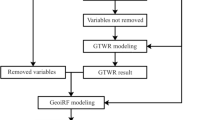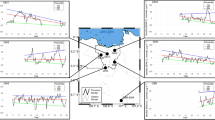Abstract
This study uses ozone in the atmosphere column collected by the Aura satellite’s ozone monitoring instrument (OMI), to evaluate the ozone pollution status of Japan. Mann–Kendall and slope trend analysis, Hurst index analysis, the potential source contribution factor algorithm, GTWR (geographically and temporally weighted regression model), and the random forest regression model were used in this paper to investigate ozone column concentrations in Japan from 2010 through 2021. The results showed that ozone column concentrations had a significant latitudinal trend over the past 12 years, i.e., concentrations increased with increasing latitude. And the slope has showed a small upward trend over the years (slope = 0.01). The interannual maximum and minimum ozone column concentrations are in 2021 (387.57 DU) and 2015 (241.27 DU), respectively. The monthly maximum and minimum values occur in March (361.60 DU) and October (286.96 DU), with seasonal concentrations in the order of Spring (352.94 DU) > Winter (336.01 DU) > Summer (306.78 DU) > Autumn (296.30 DU). Column ozone concentrations have increased in 69.82% of Japan over the past 12 years. In 2022, the maximum, minimum, and mean ozone column concentrations based on random forest forecasts are 372DU, 278DU, and 334DU, respectively. Pollution sources in Japan are largely derived from pollutants that are transported across borders from the seas around the country or from other countries in the world, with the largest potential source areas being located in the Kanto region. Relative humidity, lift index, and air temperature (in all three seasons except winter) have a negative effect on ozone column concentrations. The positive effects of precipitable water and nitrogen dioxide on ozone column concentrations in the Hokkaido locality and southern Japan were more significant. The contribution of population density and GDP to ozone is small.














Similar content being viewed by others

Data Availability
The data sets used or analyzed during the current study are available from the corresponding author on reasonable request.
References
Breiman, L. (2001). Random forests. Machine Learning, 45(1), 5–32. https://doi.org/10.1023/A:1010933404324
Breiman, L., Friedman, J. H., Olshen, R. A., & Stone, C. J. (1984). Classification and regression trees.
Chang, K.-L., Petropavlovskikh, I., Copper, O., Schultz, M., & Tao, W. (2017). Regional trend analysis of surface ozone observations from monitoring networks in eastern North America, Europe and East Asia. Elementa: Science of the Anthropocene, 5, 50. https://doi.org/10.1525/elementa.243
Chen, J., Gao, M., Cheng, S., Hou, W., Song, M., Liu, X., & Liu, Y. (2022). Global 1 km × 1 km gridded revised real gross domestic product and electricity consumption during 1992–2019 based on calibrated nighttime light data. Scientific Data, 9(1), 202. https://doi.org/10.1038/s41597-022-01322-5
Fan, J., Wang, T., Wang, Q., Ma, D., Li, Y., Zhou, M., & Wang, T. (2023). Assessment of HCHO in Beijing during 2009 to 2020 using satellite observation and numerical model: Spatial characteristic and impact factor. Science of The Total Environment, 894, 165060. https://doi.org/10.1016/j.scitotenv.2023.165060
Ho, T. K. (1992). A theory of multiple classifier systems and its application to visual word recognition.
Hollaway, M. J., Arnold, S. R., Challinor, A. J., & Emberson, L. D. (2012). Intercontinental trans-boundary contributions to ozone-induced crop yield losses in the Northern Hemisphere. Biogeosciences, 9(1), 271–292. https://doi.org/10.5194/bg-9-271-2012
Huang, B., Wu, B., & Barry, M. (2010). Geographically and temporally weighted regression for modeling spatio-temporal variation in house prices. International Journal of Geographical Information Science, 24(3), 383–401. https://doi.org/10.1080/13658810802672469
Ito, A., Wakamatsu, S., Morikawa, T., & Kobayashi, S. (2021). 30 years of air quality trends in Japan. Atmosphere, 12, 1072. https://doi.org/10.3390/atmos12081072
Ito, K., De Leon, S. F., & Lippmann, M. (2005). Associations between ozone and daily mortality: Analysis and meta-analysis. Epidemiology, 16(4), 446–457. https://doi.org/10.1097/01.ede.0000165821.90114.7f
Jasaitis, D., Vasiliauskienė, V., Chadyšienė, R., & Pečiulienė, M. (2016). Surface ozone concentration and its relationship with UV radiation, meteorological parameters and radon on the Eastern Coast of the Baltic Sea. Atmosphere, 7(2), 27. https://www.mdpi.com/2073-4433/7/2/27
Ju, T., Duan, J., Li, B., Gao, H., Fan, J., Liang, Z., et al. (2022). Analysis and research of absorbing aerosols in Beijing-Tianjin-Hebei region. Air Quality, Atmosphere & Health, 15(6), 937–950. https://doi.org/10.1007/s11869-021-01151-2
Kajii, Y., Someno, K., Tanimoto, H., Hirokawa, J., Akimoto, H., Katsuno, T., & Kawara, J. (1998). Evidence for the seasonal variation of photochemical activity of tropospheric ozone: Continuous observation of ozone and CO at Happo, Japan. Geophysical Research Letters, 25, 3505–3508. https://doi.org/10.1029/98GL02602
Kalaiarasan, G., Balakrishnan, R. M., Sethunath, N. A., & Manoharan, S. (2018). Source apportionment studies on particulate matter (PM10 and PM2.5) in ambient air of urban Mangalore, India. Journal of Environmental Management, 217, 815–824. https://doi.org/10.1016/j.jenvman.2018.04.040
Khan, R., Kumar, K. R., & Zhao, T. (2019). The climatology of aerosol optical thickness and radiative effects in Southeast Asia from 18-years of ground-based observations. Environmental Pollution, 254, 113025. https://doi.org/10.1016/j.envpol.2019.113025
Kimoto, K. (2015). Will coal save Japan and the world? Energy & Environment, 26(6-7), 1055–1067. https://doi.org/10.1260/0958-305X.26.6-7.1055
Lefohn, A. S., Malley, C. S., Smith, L. A., Wells, B., Hazucha, M., Simon, H., et al. (2018). Tropospheric ozone assessment report: Global ozone metrics for climate change, human health, and crop/ecosystem research. Elementa: Science of the Anthropocene, 6. https://doi.org/10.1525/elementa.279
Li, J., Yang, W., Wang, Z., Chen, H., Hu, B., Li, J., et al. (2016). Modeling study of surface ozone source-receptor relationships in East Asia. Atmospheric Research, 167, 77–88. https://doi.org/10.1016/j.atmosres.2015.07.010
Liu, J., Strode, S., Liang, Q., Oman, L., Colarco, P., Fleming, E., et al. (2022). Change in tropospheric ozone in the recent decades and its contribution to global total ozone. Journal of Geophysical Research: Atmospheres, 127(22) https://ui.adsabs.harvard.edu/abs/2021AGUFM.A31G..07L
Liu, N., Lin, W., Ma, J., Xu, W., & Xu, X. (2019). Seasonal variation in surface ozone and its regional characteristics at global atmosphere watch stations in China. Journal of Environmental Sciences, 77, 291–302. https://doi.org/10.1016/j.jes.2018.08.009
Ma, Y., Liu, Q., Bian, Y., Feng, L., Zhao, D., Wang, S., et al. (2021). Analysis of transport path and source distribution of winter air pollution in Shenyang. Open Geosciences, 13, 1105–1117. https://doi.org/10.1515/geo-2020-0292
Mukantseva, L. A. (1978). Testing normality in one-dimensional and multi-dimensional linear regression. Theory of Probability & Its Applications, 22(3), 591–602. https://doi.org/10.1137/1122073
Nagashima, T., Ohara, T., Sudo, K., & Akimoto, H. (2010). The relative importance of various source regions on East Asian surface ozone. Atmospheric Chemistry and Physics, 10(22), 11305–11322. https://doi.org/10.5194/acp-10-11305-2010
Nagashima, T., Sudo, K., Akimoto, H., Kurokawa, J., & Ohara, T. (2017). Long-term change in the source contribution to surface ozone over Japan. Atmospheric Chemistry and Physics, 17(13), 8231–8246. https://doi.org/10.5194/acp-17-8231-2017
Oltmans, S. J., Lefohn, A. S., Shadwick, D., Harris, J. M., Scheel, H. E., Galbally, I., et al. (2013). Recent tropospheric ozone changes – A pattern dominated by slow or no growth. Atmospheric Environment, 67, 331–351. https://doi.org/10.1016/j.atmosenv.2012.10.057
Parrish, D. D., Law, K. S., Staehelin, J., Derwent, R., Cooper, O. R., Tanimoto, H., et al. (2012). Long-term changes in lower tropospheric baseline ozone concentrations at northern mid-latitudes. Atmospheric Chemistry and Physics, 12(23), 11485–11504. https://doi.org/10.5194/acp-12-11485-2012
Ren, J., Guo, F., & Xie, S. (2022). Diagnosing ozone–NOx–VOC sensitivity and revealing causes of ozone increases in China based on 2013–2021 satellite retrievals. Atmospheric Chemistry and Physics, 22(22), 15035–15047. https://doi.org/10.5194/acp-22-15035-2022
Sánchez Granero, M. A., Trinidad Segovia, J. E., & García Pérez, J. (2008). Some comments on Hurst exponent and the long memory processes on capital markets. Physica A: Statistical Mechanics and its Applications, 387(22), 5543–5551. https://doi.org/10.1016/j.physa.2008.05.053
Shibata, Y., & Morikawa, T. (2021). Review of the JCAP/JATOP air quality model study in Japan. Atmosphere, 12, 943. https://doi.org/10.3390/atmos12080943
Silva, R. A., West, J. J., Zhang, Y., Anenberg, S. C., Lamarque, J.-F., Shindell, D. T., et al. (2013). Global premature mortality due to anthropogenic outdoor air pollution and the contribution of past climate change. Environmental Research Letters, 8(3), 034005. https://doi.org/10.1088/1748-9326/8/3/034005
Tanimoto, H. (2009). Increase in springtime tropospheric ozone at a mountainous site in Japan for the period 1998–2006. Atmospheric Environment, 43(6), 1358–1363. https://doi.org/10.1016/j.atmosenv.2008.12.006
Tanimoto, H., Ohara, T., & Uno, I. (2009). Asian anthropogenic emissions and decadal trends in springtime tropospheric ozone over Japan: 1998-2007. Geophysical Research Letters, 36. https://doi.org/10.1029/2009GL041382
Wakamatsu, S., Morikawa, T., & Ito, A. (2013). Air pollution trends in Japan between 1970 and 2012 and impact of urban air pollution countermeasures. Asian Journal of Atmospheric Environment, 7. https://doi.org/10.5572/ajae.2013.7.4.177
Xiao, Q., Zhang, H., Choi, M., Li, S., Kondragunta, S., Kim, J., et al. (2016). Evaluation of VIIRS, GOCI, and MODIS collection 6 AOD retrievals against ground sunphotometer observations over East Asia. Atmospheric Chemistry and Physics, 16(3), 1255–1269. https://doi.org/10.5194/acp-16-1255-2016
Yamaji, K., Ohara, T., Uno, I., Tanimoto, H., & Kurokawa, J.-i., & Akimoto, H. (2006). Analysis of the seasonal variation of ozone in the boundary layer in East Asia using the community multi-scale air quality model: What controls surface ozone levels over Japan? Atmospheric Environment, 40(10), 1856–1868. https://doi.org/10.1016/j.atmosenv.2005.10.067
Yuan, Y., Liu, J., Gao, B., & Hao, J. (2021). Ozone direct oxidation pretreatment and catalytic oxidation post-treatment coupled with ABMBR for landfill leachate treatment. Science of The Total Environment, 794, 148557. https://doi.org/10.1016/j.scitotenv.2021.148557
Ziemke, J. R., Oman, L. D., Strode, S. A., Douglass, A. R., Olsen, M. A., McPeters, R. D., et al. (2019). Trends in global tropospheric ozone inferred from a composite record of TOMS/OMI/MLS/OMPS satellite measurements and the MERRA-2 GMI simulation. Atmospheric Chemistry and Physics, 19(5), 3257–3269. https://doi.org/10.5194/acp-19-3257-2019
Funding
This work was supported by the Natural Science Foundation of Gansu Province (CN)(17YF1FA120) at the Key Laboratory of Resource Environment and Sustainable Development of Oasis, Gansu Province.
Author information
Authors and Affiliations
Contributions
Shengtong Lei: conceptualization, formal analysis, methodology, data curation, writing—original draft; Tianzhen Ju: software, resources, project administration, writing—review and editing; Bingnan Li: embellish; Xuhui Xia: software teaching; Cheng Huang: drawing teaching; Jiaming Zhang: part of datas provided; Chunxue Li: drawing teaching. All authors have read and agreed to the published version of the manuscript.
Corresponding author
Ethics declarations
Ethical Approval
Ethics approval was not required for this research.
Consent to Participate
This paper does not require consent to participate.
Consent for Publication
The first author and the responsible author agree to publish the paper.
Competing Interests
The authors declare no competing interests.
Additional information
Publisher’s Note
Springer Nature remains neutral with regard to jurisdictional claims in published maps and institutional affiliations.
Rights and permissions
Springer Nature or its licensor (e.g. a society or other partner) holds exclusive rights to this article under a publishing agreement with the author(s) or other rightsholder(s); author self-archiving of the accepted manuscript version of this article is solely governed by the terms of such publishing agreement and applicable law.
About this article
Cite this article
Lei, S., Ju, T., Li, B. et al. Analysis of Remote Sensing Monitoring of Atmospheric Ozone in Japan from 2010 to 2021. Water Air Soil Pollut 234, 562 (2023). https://doi.org/10.1007/s11270-023-06586-0
Received:
Accepted:
Published:
DOI: https://doi.org/10.1007/s11270-023-06586-0



